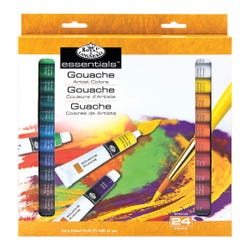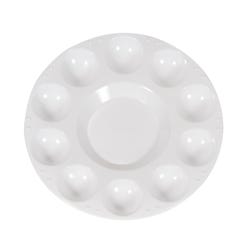One Petal, Two Petals, Three Petals More

Description
Lesson Plan and Artwork by Jack Matthews
What is a “filbert”? Many students have never worked with this particular type of brush. Generally, one would use this brush to create botanical objects—primarily, flowers. This lesson will allow for experimentation, use of mathematical structure, and finally a completed floral composition.
Objectives
- Experiment with various sizes of filbert brushes in order to develop leaf and petal shapes, and to learn how to “load” the brush with one or more pigments.
- Look at various compositions of floral arrangements in paintings and photographs, paying close attention to the “geometric” format of the composition (triangle, S-curve, circle, etc.).
- Develop a composition, using the filbert brushes to create a floral composition as in a still life, or an outdoor vista.
Supplies Needed
Royal & Langnickel® Big Kid’s Choice™ Filbert Brushes, Assorted Sizes, Set of 5
Royal & Langnickel® Essentials Gouache, 0.71 Oz, Assorted Colors, Set of 24
Crescent® 8 Ultra-Black™ Mounting Board, 11 x 14”, Pack of 40
School Smart® Student Paint Palette, 7”, White, Pack of 12
*Here are the supplies needed for this lesson plan for reference. Find a convenient carousel of shoppable products for this lesson below.
Standards
Standard #1: Generate and conceptualize artistic ideas and work.
Standard #2: Organize and develop artistic ideas and work.
Standard #3: Refine and complete artistic work.
Instructions
1
Teacher will share images of floral arrangements in paintings and photographs, emphasizing compositional shape of the arrangement. A discussion of lights and darks, background vs. foreground, and detail to petals will be included.
2
Teacher will demonstrate use of the filbert brush, loading single and multiple colors. Students will use this time to practice petal shapes, looking at either a real or artificial flower. NOTE: The easiest flowers for students to successfully create are the daisy, browneyed susan, or spider mum.
3
It is suggested the teacher set up several stations with floral arrangements in the following shapes:

Otherwise, the teacher needs to provide images of floral settings.
4
Using a black background, students will sketch areas for flowers. NOTE: Composition of flowers is to fill the majority of the picture plane.
5
If necessary, students may “block-in” the flower shape first, using the base color of the flower. Using the techniques for creating petals, students will begin painting flower shapes, building up petal to petal. NOTE: A small amount of white gouache must be added to the color pigment so that the paint strokes will be visible enough on the black background.
6
Leaf shapes may be added as well as stems if desired.
7
Details will be added last, and may be created using the edge of a small filbert or using a small round. It is not necessary to add a vase or other container if the student has filled the canvas adequately. Additionally, the entire black surface does not have to be covered; that is a personal choice.




